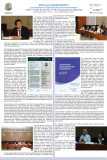RCEs and Biodiversity: Local Solutions Linking Education and Implementation
| Date: Monday, 8 October 2012 |
| Time: 13:15–14:45 |
| Venue: Room G.01 - Ground level |
| Partners: RCE Partners |
|
A meeting of selected RCEs from across the Asia Pacific region was organized by the UNU-IAS as a side event during the COP - XI held at Hyderabad in October 2012. The meeting shared experiences and best practices derived from a range of case studies that highlighted the work of the different RCEs within their areas of operation. UNU-IAS, as part of its series of publications “Innovation in Local and Global Learning Systems for Sustainability”, has compiled a book titled “Traditional Knowledge and Biodiversity: Learning Contributions of the RCEs on ESD”. A ‘pre-release’ version of the publication containing 18 success stories received from 16 different RCEs was launched during this meet. |

 The meeting was chaired by Mr. Kazuhiko Takemoto, ESD Program Director, UNU-IAS; Panelists included Dr. Rolando Inciong of ASEAN Centre of Biodiversity, Bangkok and Dr. Ram Boojh, of UNESCO South Asia Office, New Delhi; other participants included members of the UNU-IAS and speakers from RCE Cha-am, Thailand; RCE Chubu, Japan; RCEs Srinagar, and Chandigarh, India and RCE Phnom Penh, Cambodia. The event also attracted guests from a wide range of disciplines who were curious to learn about RCEs and the scope of the work undertaken by this world-wide ESD network.
The meeting was chaired by Mr. Kazuhiko Takemoto, ESD Program Director, UNU-IAS; Panelists included Dr. Rolando Inciong of ASEAN Centre of Biodiversity, Bangkok and Dr. Ram Boojh, of UNESCO South Asia Office, New Delhi; other participants included members of the UNU-IAS and speakers from RCE Cha-am, Thailand; RCE Chubu, Japan; RCEs Srinagar, and Chandigarh, India and RCE Phnom Penh, Cambodia. The event also attracted guests from a wide range of disciplines who were curious to learn about RCEs and the scope of the work undertaken by this world-wide ESD network.
